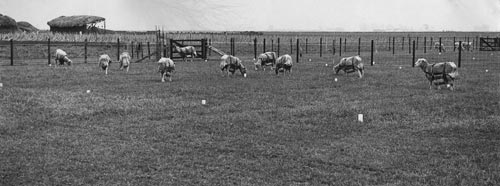
When soil fertility began to decline (by the 1890s in the South Island and the 1920s in the North Island), and with it farming productivity, scientists experimented with ways to improve pasture production. Bruce Levy argued that stock recycled nitrogen and other plant nutrients in their droppings and urine, in what he called a ‘shower of fertility’ – so increasing stock numbers could raise the land’s fertility. Levy’s theory was tested in the 1940s. These sheep have been fitted with bags and bottles to catch their waste, and compare the results of withholding it or returning it to the pasture. The experiment showed that Levy was essentially correct.
Using this item
This item has been provided for private study purposes (such as school projects, family and local history research) and any published reproduction (print or electronic) may infringe copyright law. It is the responsibility of the user of any material to obtain clearance from the copyright holder.






Add new comment